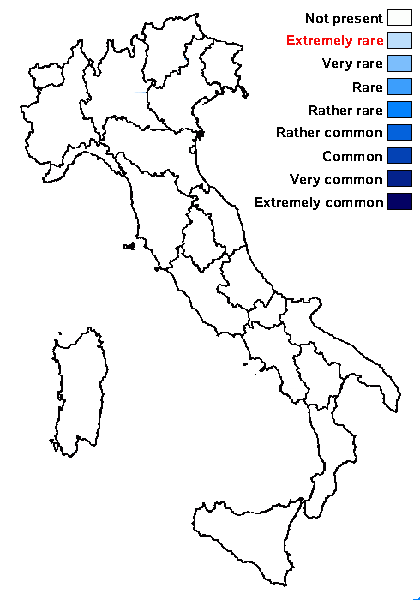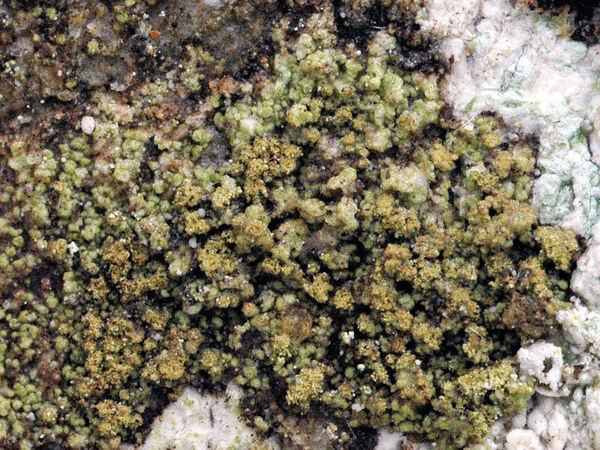Fuscidea arboricola Coppins & Tønsberg
in Tønsberg, Sommerfeltia, 14: 134, 1992
Synonyms:
Distribution:
Description: Thallus crustose, episubstratic, continuous to areolate-tuberculate, grey, greenish or brownish, forming 3(-5) cm wide patches, sorediate, often delimited by a brown prothallus. Areoles discrete or locally fused, convex, sometimes bullate, circular to irregular in outline, 0.2-0.3 mm wide, often esorediate in marginal parts of thallus, otherwise soon bursting apically into punctiform to orbicular, 0.2-0.5 mm wide, pale yellowish green to pale green soralia (sometimes tinged brown due to pigmentation of the external soredia); soredia farinose, (15-)20-30 μm wide, the external (exposed) ones with a brownish wall. Apothecia rather rare, biatorine, up to 0.8 mm across, with a more or less flat, dark brown to brown-black disc, and a distinct, concolorous, often flexuose proper margin. Proper exciple brown in outer part, paler brown to colourless within, of radiating, firmly conglutinated hyphae, with colourless crystals reacting P+ orange and dissolving in K; epithecium brown K-, N-; hymenium colourless, 45-75 µm high, I+ faintly blue-violet; paraphyses simple or sparingly branched, coherent in water but becoming free in K, 1.5-2 µm thick at mid-level. the upper cell up to 3.5(-4) µm wide, with a brown cap; hypothecium 40-60 µm high, I+ faintly blue-violet. Asci 8-spored, clavate, with a thin external and internal K/I+ dark blue cap surrounded by a thick K/I+ pale blue apical cap, and with a K/I- apical tube in tholus, Fuscidea-type. Ascospores simple to 1-septate, hyaline turning brownish, with a distinct median constriction, more or less oblong, 7-9 x 4-5 µm. Pycnidia rare, mostly marginal, blackish brown, sessile, up to 0.3(-0.5) mm across, with a widely gaping ostiole. Conidia narrowly obovoid to bacilliform, 3-3.5 x 1-1.5 µm. Photobiont chlorococcoid. Spot tests: thallus K-, C-, KC-, P+ red, UV-. Chemistry: fumarprotocetraric acid (major), protocetraric acid (traces).Note: on bark of broad-leaved trees in various forest types, from the lowlands to the montane belt; widespread in Europe and Eastern North America; there are several scattered records from the Alps (outside the Italian territory), where the species was certainly undercollected, being often sterile. To be looked for in Italy
Growth form: Crustose
Substrata: bark
Photobiont: green algae other than Trentepohlia
Reproductive strategy: mainly asexual, by soredia, or soredia-like structures (e.g. blastidia)

Predictive model
Growth form: Crustose
Substrata: bark
Photobiont: green algae other than Trentepohlia
Reproductive strategy: mainly asexual, by soredia, or soredia-like structures (e.g. blastidia)

Predictive model
 Index Fungorum
Index Fungorum
 GBIF
GBIF


